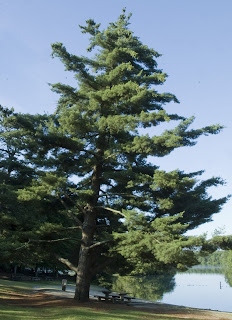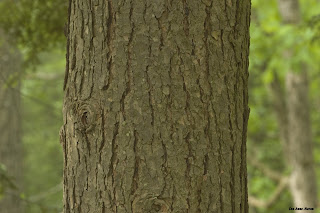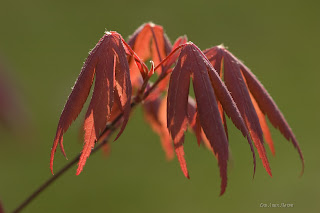Common Name: Balsam Fir
Family Name: Pinaceae
EVERGREEN
Plant is Native to: North America, especially in the higher altitude from Labrador to Alberta to Pennsylvania. Cultivated since 1696. Hardy in Zone 3 to 5.
Plant Height at maturity: 45' to 75' by 20-30' spread.
Plant Habit and Form: Stiff in habit, symmetrically pyramidal or narrow-conical when young, but loses pyramidal shape with age.
Foliage: 5/8" to 1" long, 1/20 to 1/16" wide, horizontally arranged in 2 lateral sets with V-shaped parting between; apex slightly notched, upper surface shining dark green with interrupted lines of stomata towards the tip; lower surface has 2 gray bands of stomata; balsam odor.
 Photo: West Simsbury, CT
Photo: West Simsbury, CT
Bark: Dull green, later grayish areas; smooth with numerous raised resin blisters. Breaking up into small reddish brown, scaly plates, ½" thick.
 Photo: Keith Kanoti, Maine Forest Service, Bugwood.org
Photo: Keith Kanoti, Maine Forest Service, Bugwood.org
Flower: Male: yellow, catkin-like, develops from underside of leaf axil.
 Photo: Joseph O'Brien, USDA Forest Service, US
Photo: Joseph O'Brien, USDA Forest Service, US
Fruit/Seed: Cone: dark violet when young, 2 to 4" long, turning gray-brown and resinous at maturity. Once seeds ripen, scales fall off, leaving only central axis.
 Photo: http://www.jungleseeds.com/SeedShop/HardyTrees.htm
Photo: http://www.jungleseeds.com/SeedShop/HardyTrees.htm
Growing Requirements: Likes moist, well-drained, acid soil, with high humidity and cooler temperatures. Slow growth. Best to plant in spring, using small container grown or balled and burlapped plants.
Problems and Drawbacks: Looks good in its youth, but in hot, dry climates may lose leaves and look unkempt. Susceptible to spruce budworm, woolly adelgid and several canker diseases. Does not tolerate air pollution, therefore doesn’t do well in cities.
Special Uses: Popular as Christmas tree; landscape value as specimen tree or in groupings.
ID Tips/Remarks: Leaf has a definite balsam scent.
Bibliography:
Dirr, Michael A. Manual of Woody Landscape Plants, 1998 Stipes Publishing, Champaigne, IL
http://www.hort.uconn.edu/plants/a/abibal/abibal1.html


 Photo: Long Island, NY
Photo: Long Island, NY Photo: Voluntown, CT
Photo: Voluntown, CT


 Photos: Long Island, NY
Photos: Long Island, NY Photo: Cedar Hill Cemetary, Hartford, CT
Photo: Cedar Hill Cemetary, Hartford, CT






 Photo: Hill-Stead Museum, Farmington, CT
Photo: Hill-Stead Museum, Farmington, CT
 Photo: Wadsworth Estate, Middletown, CT
Photo: Wadsworth Estate, Middletown, CT


 Photos: Wadsworth Estate, Middletown, CT
Photos: Wadsworth Estate, Middletown, CT





 Voluntown, CT
Voluntown, CT
 Evergreen Way, Manchester, CT
Evergreen Way, Manchester, CT 




 West Simsbury, CT
West Simsbury, CT
 Burlington, Ontario, Canada
Burlington, Ontario, Canada










